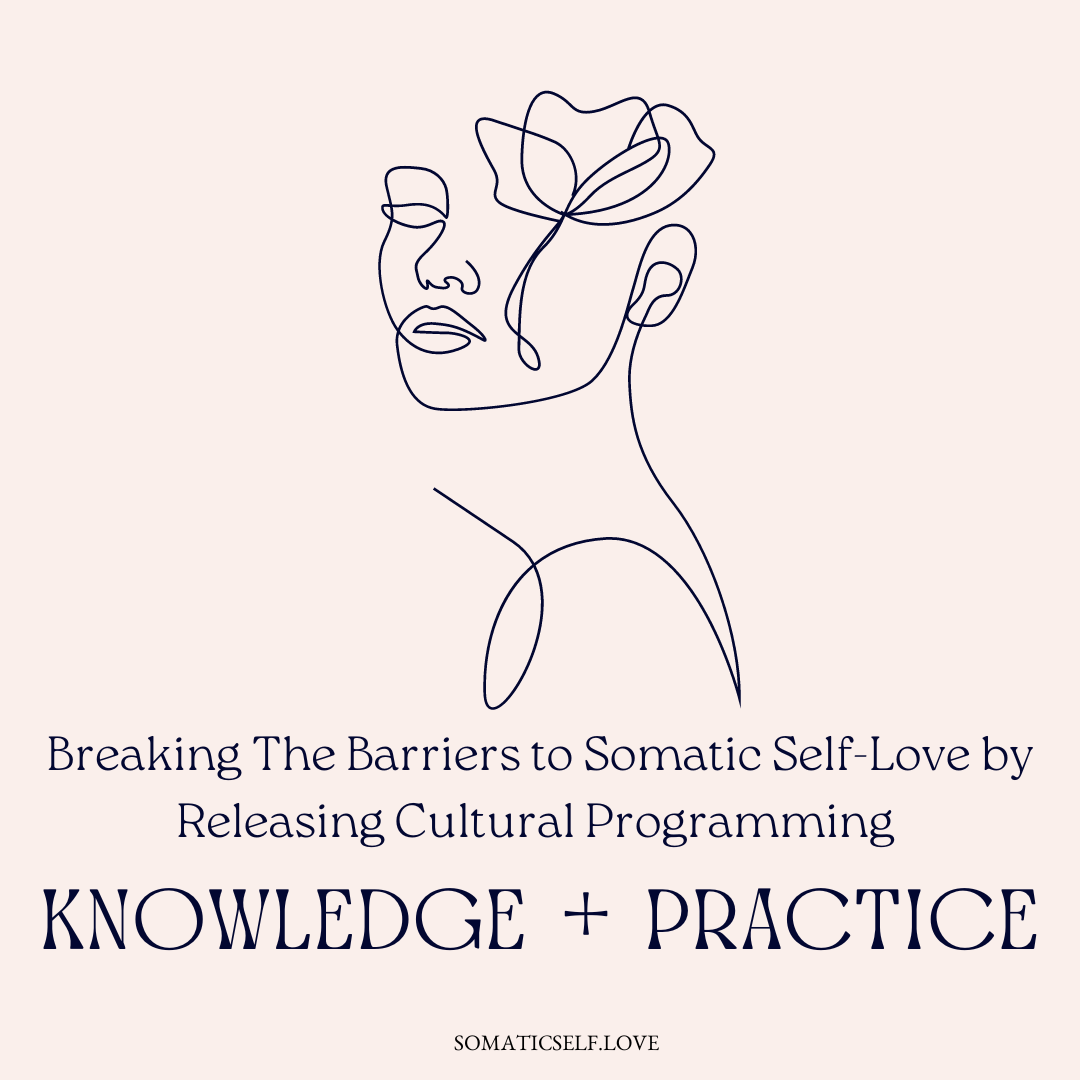Breaking The Barriers to Somatic Self-Love by Releasing Cultural Programming

Cultural programming: a powerful yet invisible force that shapes our thoughts, beliefs, and actions, often without us even realizing it. It seeps into our lives through various channels – from the media we consume to the values imparted by our families and even the religious teachings we follow. As we navigate our complex world, these subtle messages guide our choices, molding us into the individuals we become.

But what happens when these societal norms clash with our personal experiences? For those who’ve faced developmental abuse or struggle with unresolved CPTSD, the impact of cultural programming can be even more profound. It may instill a sense of inadequacy as we cannot measure up to the “ideal” standards promoted by society.
Meeting the Expectations
Dig deeper, and you’ll uncover a myriad of internalized beliefs that have persisted for centuries. At the core of these lies the patriarchal system, which has long dictated societal expectations and norms. One glaring example is androcentrism, a cultural and ideological system that positions men as superior, placing their experiences and values on a pedestal above those of women. This insidious hierarchy permeates every aspect of life, from the way history is taught to the roles and behaviors expected of each gender.
How Does This Land In Our Bodies?
But how do these cultural forces manifest in our physical selves? Enter the world of somatic coaching, where the concept of “shapes” takes center stage. These patterns of tension, movement, and posture held within our bodies are not just physical, but emotional and mental too. They can be both conscious and unconscious, reflecting our emotional states and histories.
Take, for instance, the person who carries the weight of trauma in their shoulders and neck. This tension may result in feelings of anxiety or hypervigilance, affecting their overall well-being and quality of life. By recognizing and addressing these “shapes,” we can begin to untangle the web of cultural programming that binds us, ultimately leading to greater self-awareness and personal growth.

Practicing Somatic Self-Love
Embarking on a journey of somatic self-love, we navigate the intricate labyrinth of cultural programming and oppressive systems. As we delve into somatic self-love practices, we begin to unravel the layers of shaping that constitute our experience.
As we dive deep into self-exploration, we encounter the subtle, almost imperceptible forces shaping our capacity to love ourselves, give and receive love, and feel the flow of energy in our bodies. These cultural undercurrents, swirling beneath the surface, exert their influence on our ability to love ourselves.
Somatic self-love invites us to confront these hidden aspects of our lives, both individually and collectively. It challenges us to embrace the love that resides within us, in spite of – and perhaps because of – the cultural baggage we have inherited and been taught. We are, after all, creatures of our environment, swimming in a sea of influences that we absorb and internalize.

As we engage in somatic exercises, we delve deeper into the recesses of our being, unearthing the shapes and attitudes that have been etched into our bodies. Through this process, we can begin to reshape ourselves, cultivating a living, breathing embodiment of self-love that defies the constraints of cultural programming.
So, let us embark on this journey together, embracing both the seen and unseen as we traverse the ever-shifting landscape of self-exploration and transformation. In doing so, we will find ourselves better equipped to navigate the complexities of life and love, and ultimately, to reshape our bodies and our world.
How can I identify cultural programming that may be stored in my body?
Identifying cultural programming that may be stored in the body can be challenging, as it may be deeply ingrained and may feel like a normal part of your experience. Here are some strategies that can help:
- Bring awareness to your thoughts and emotions: Notice any negative self-talk or beliefs that may be connected to cultural programming. For example, you may notice beliefs about beauty standards or body image that feel limiting or oppressive. By observing these thoughts and emotions, you can begin to identify patterns that may be connected to cultural programming.
- Notice physical sensations in the body: Cultural programming can often manifest as physical tension or discomfort in the body. Notice any areas of tension or discomfort, and consider whether these may be connected to cultural programming. For example, you may notice tension in your shoulders or neck that may be connected to cultural messages about gender roles or expectations.
- Reflect on your upbringing and experiences: Consider how your upbringing and experiences may have influenced your beliefs and attitudes. Reflect on messages that you may have received from family, friends, media, or other sources that may have contributed to cultural programming.
- Seek out diverse perspectives: Engage with a diversity of perspectives and experiences to challenge and expand your own beliefs and attitudes. This may involve reading books by authors from different backgrounds, seeking out new social connections or communities, or engaging with diverse media.
- Seek support from others: Seek support from a trained professional or a supportive community to help identify and address cultural programming. A licensed therapist, somatic practitioner, or support group can provide a safe and non-judgmental space for exploring these beliefs and patterns, and can offer guidance and support in creating new patterns and beliefs that promote self-love and acceptance.
Overall, identifying cultural programming that may be stored in the body requires bringing awareness to your thoughts, emotions, and physical sensations, and actively working to challenge and dismantle oppressive systems. By engaging in somatic practices and seeking support from others, individuals can begin to recognize and challenge these beliefs and patterns, and move towards greater empowerment.
Somatic Self-Love Practice: Naming and Releasing Cultural Progamming
A step-by-step practice for self-massage that can help to release cultural programming that may be stored in the body:
- Find a quiet and comfortable space where you can lie down or sit comfortably. You may want to play calming music or light candles to create a relaxing environment.
- Take a few deep breaths and focus on relaxing the body. Close your eyes and bring your attention to the physical sensations in your body.
- Begin to massage areas of the body where you feel tension or discomfort. This may include the neck, shoulders, back, hips, or feet. Use gentle pressure and slow, deliberate movements, and focus on releasing physical tension in the body.
- As you massage each area, notice any thoughts or emotions that arise. You may notice memories, beliefs, or emotions that are connected to cultural programming. Try to observe these thoughts and emotions without judgment, and allow them to come and go.
- If you notice any thoughts or emotions that feel particularly challenging or uncomfortable, you may want to pause the massage and take a few deep breaths. Bring your attention to the physical sensations in the body, and allow yourself to feel whatever is present.
- After you have finished the massage, take a few moments to rest and relax. Notice how you feel in the body and mind, and observe any shifts or changes that may have occurred.
This self-massage practice can be a helpful way to release physical tension and emotional stress that may be connected to cultural programming. By bringing attention to the body and observing thoughts and emotions without judgment, we access deeper levels of awareness and begin to release limiting or oppressive beliefs and patterns.